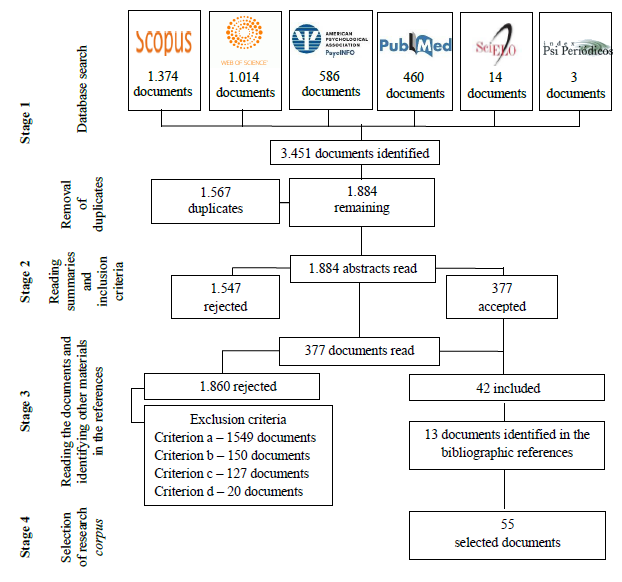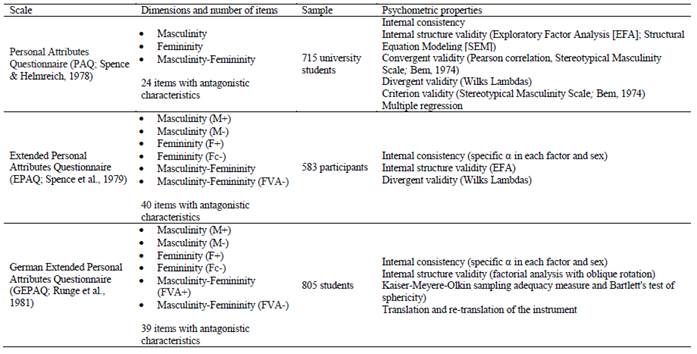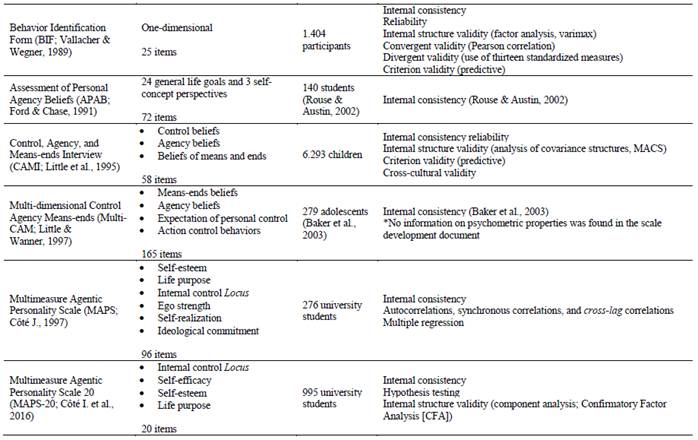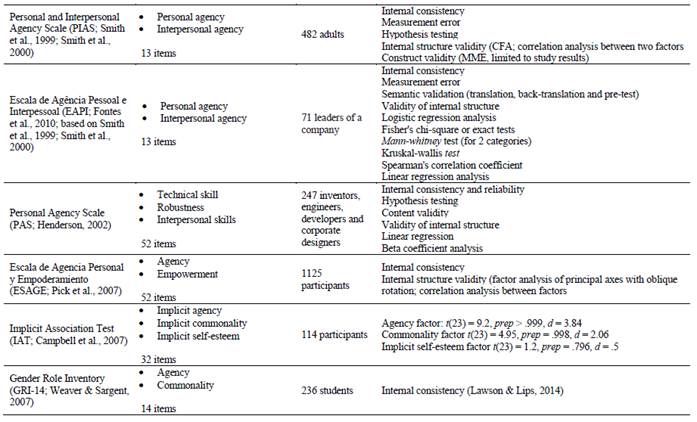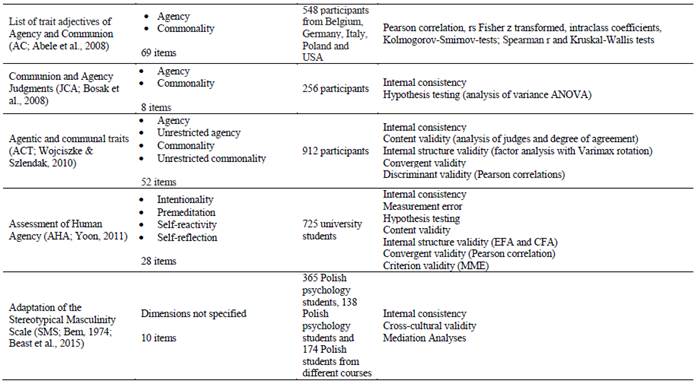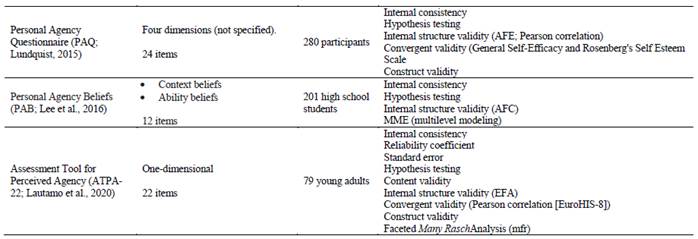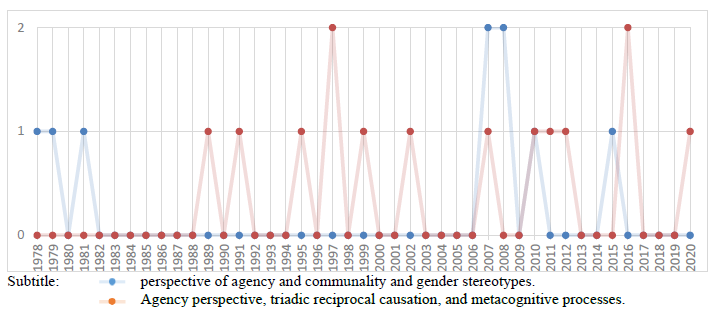Services on Demand
Journal
Article
Related links
Share
Ciencias Psicológicas
Print version ISSN 1688-4094On-line version ISSN 1688-4221
Cienc. Psicol. vol.17 no.2 Montevideo Dec. 2023 Epub Dec 01, 2023
https://doi.org/10.22235/cp.v17i2.2706
Original Articles
Psychometric properties of agency measuring instruments: a systematic review
1Universidade Federal de Santa Catarina, Brasil, mariajuliagai@hotmail.com.
2Universidade Federal de Santa Catarina, Brasil
3Universidade de Évora, Portugal
4 Universidade Federal de Santa Catarina, Brasil
5 Universidade Federal de Santa Catarina, Brasil
Agency capacity, related to the perception of protagonism on making decisions about one's own life, currently presents a previous record of investigations based on empirical studies, but there is still a lack of definition around the concept and the measurement of the phenomenon, considering the simplifications and generalizations observed. With that in mind, the goal of this systematic literature review is to analyze the psychometric properties of instruments for measuring personal agency. A systematic literature review was carried out with searches in six Brazilian and international databases on publications from up to 2020. We identified 23 instruments with this proposal, from the 55 documents analyzed. There were fragilities regarding the robustness of the presented psychometric properties, since most of them are limited to the internal structure validity. The convergent and divergent validities are little explored. An agency measurement instrument with statistical validation for the Brazilian context was not identified, only one instrument with semantic validation was found. The development of an instrument adapted to the Brazilian context is the main recommendation for future studies.
Keywords: agency; personal agency; psychometric properties; measurement instruments
A capacidade de agência, relacionada à percepção de protagonismo na tomada de decisões sobre a própria vida, já apresenta um histórico de investigações a partir de estudos empíricos, mas ainda existem indefinições conceituais e de mensuração do fenômeno, em que são observadas simplificações e generalizações do construto. Tendo isso em vista, o objetivo desta revisão sistemática da literatura é analisar as propriedades psicométricas de instrumentos de mensuração da agência pessoal. Executou-se uma revisão sistemática de literatura com buscas em seis bases de dados brasileiras e internacionais de publicações até 2020. Dos 55 documentos analisados, identificaram-se 23 instrumentos com essa proposta. Observaram-se fragilidades no tocante à robustez das propriedades psicométricas apresentadas, já que a maior parte se limita à validade de estrutura interna. As validades convergente e divergente são pouco exploradas. Não foi identificado um instrumento de mensuração da agência com validade estatística para o contexto brasileiro, pois encontrou-se apenas um instrumento com validação semântica. O desenvolvimento de um instrumento adaptado para o contexto brasileiro é a principal recomendação para estudos futuros.
Palavras-chave: agência; agência pessoal; propriedades psicométricas; instrumentos de mensuração
La capacidad de agencia, relacionada con la percepción de protagonismo en la toma de decisiones sobre la propia vida, presenta un historial de investigaciones basadas en estudios empíricos, pero aún existen incertidumbres conceptuales y de medición del fenómeno en las que se hacen simplificaciones y generalizaciones del concepto. Teniendo esto en cuenta, el objetivo de esta revisión sistemática de la literatura es analizar las propiedades psicométricas de los instrumentos de medición de la agencia personal. Se realizó una revisión bibliográfica sistemática con búsquedas en seis bases de datos brasileñas e internacionales hasta 2020. De los 55 documentos analizados, se identificaron 23 instrumentos con esta propuesta. Se observaron debilidades en cuanto a la robustez de las propiedades psicométricas presentadas, ya que la mayoría se limita a la validez de la estructura interna. La validez convergente y divergente son poco exploradas. No se identificó un instrumento de medición de agencia que tenga validez estadística para el contexto brasileño, ya que solo se encontró un instrumento con validación semántica. El desarrollo de un instrumento adaptado al contexto brasileño es la principal recomendación para futuros estudios.
Palabras clave: agencia; agencia personal; propiedades psicométricas; instrumentos de medida
The ability to make choices, set goals, and act on those decisions are hallmarks of agency capacity. In this process, the possibility of having alternatives is configured as a fundamental factor for the deliberation on one's own volition to be carried out with more openness. Such a phenomenon involves aspects related to motivation, meaning and purpose, which end up influencing this perception of “internal power” (Kabeer, 1999, p.438). This resource has implications beyond the personal sphere, since it ends up causing impacts at a social and economic level (Cauce & Gordon, 2012). Human agency is attributed to external influences, personal factors and motivation for behavior, which influence and trigger one another in a reciprocal and interactive way (Bandura, 1989, 2018).
Record shows that such capacity for protagonism in making decisions about one's own life has been the object of previous investigations based on empirical studies, but there are still uncertainties about the conceptualization and measurement of the phenomenon. To assist in the design of this process, a review of the literature on the subject with a focus on research techniques provides room to advance in future studies, since the information discovered so far is important in order to avoid previously observed misconceptions. An example that illustrates this need for understanding regarding construct and measurement techniques is the very use of self-efficacy scales to measure agency. We know that it is a related dimension, but that it does not include the agency capacity as a whole (Alkire, 2005).
Landes and Settersten Jr. (2019) expand the perception of agency when it comes to the influence of interpersonal relationships on this capacity, and criticize the lack of recognition of this aspect in the literature, even though it is encompassed in Bandura's conceptualization as part of external influencers. The authors pointed out that human agency is dependent on relational aspects, and proposed that the conceptualization and measurement of agency require that we consider people's lives as interconnected. That way, in order for agency to be manifested, this notion of total independence is not necessary.
Due to this difficulty in the theoretical delimitation, the methodological aspects of the research are also impacted, and we can observe simplifications and generalizations regarding the construct. In several studies we can observe the use of instruments for the purpose of measuring agency, which in actuality refer to related phenomena or agency factors, such as self-efficacy, self-determination, locus of control, and which do not cover all the necessary aspects (Pick et al., 2007). Some examples are the study by Vidrine et al. (2009), which used a scale of self-efficacy scale and a questionnaire to assess expectations of affective regulation; the study by Friestad and Skog Hansen (2010) and Graff (2016), who used a general self-efficacy scale; as well as the Brazilian study by Dressler et al. (2019), which used as a measure of sense of personal agency a combination of scales of locus of control and tolerance of frustration.
In cases where the goal is to measure agency focused on a specific context, other related factors can be added according to the need, but the multidimensionality of the phenomenon must be ensured, regardless of the strategy chosen for measurement (Cauce & Gordon, 2012). Therefore, the need to construct the phenomenon to be measured is evidenced, as previously pointed out by Lautamo et al. (2020) when developing an instrument for measuring agency. In this process, verification of the psychometric properties of such tools becomes fundamental in order to assess the quality of the instruments and to understand how they were developed. The relevance of this type of literature review focusing on measurement instruments is in providing the means to choose the most suitable instrument for further research based on scientific evidence (Mokkink et al., 2016).
With that in mind, the objective of this systematic literature review is to analyze the psychometric properties of personal agency measurement instruments. It is worth mentioning that we identified no systematic reviews in the reviewed literature that met the proposed objective, characterizing a gap in research on the subject. Such progress is important for the verification and analysis of the agency's existing measurement instruments to support the construction of new construct measures.
Materials and method
A systematic literature review allows us to contrast, analyze and synthesize the findings contained in the literature with methodological rigor. More specifically, this research is a systematic review with a psychometric focus, seeing as it promotes the analysis of the psychometric properties of instruments, which makes it possible to examine reliability and validity indices (Munn et al., 2018). In this research we analyzed the measurement instruments of a single construct: personal agency. We used the protocol for systematic reviews based on PRISMA, with steps that include the identification, screening, eligibility and inclusion of documents (Page et al., 2021).
During the stage of search and identification of research corpus, the databases listed were Scopus, Web of Science, PsycINFO, Medline, SciELO and IndexPsi, the first four being international bases and the last two national. The searches were carried out on October 21, 2020, updated on February 14, 2021 by two reviewers who used the strategy: (“sense of agency” OR “human agency” OR “judgment of agency” OR “agency judgment” OR “personal agency” OR “types of agency” OR “forms of agency” OR “perceived agency” OR “feelings of agency”) AND (measur* OR assessment OR validity OR evaluation OR inventory OR scale OR “measures of agency” OR instrument)), searched in titles, abstracts and keywords with the exception of SciELO, in which we searched only by title and abstract due to the limitation of the search platform. The two national databases included the same terms in Portuguese and Spanish.
As search filters, we limited the results to documents in Portuguese, English and Spanish, with the exception of PsycINFO, where it was not possible to include the language filter. In addition to the databases, we used the references of the articles already found to seek other documents to attach to the research corpus. At the end of this stage, we downloaded the databases and the screening stage began. We removed duplicate data and two independent reviewers began eligibility analysis by reading the abstracts, considering the following inclusion criteria: a) approach the concept of agency from the cognitive and behavioral perspective; b) quantitative or mixed studies; c) mention of psychometric instruments that measure personal agency; d) be in Portuguese, English or Spanish and available for online access.
The last stage of data collection refers to the extraction of data from documents, seeking information about the instruments used, dimensionality, number of items, population and sample, and psychometric properties. During data analysis, we used the COSMIN checklist (Consensus-based Standards for the selection of health status Measurement Instruments), a tool that assists in evaluation of methodological quality in research on the measurement properties of instruments (Mokkink et al., 2010). For this study, we used only the items related to the identification of measurement properties, which are: internal consistency, reliability, measurement error, content validity, internal structure validity, hypothesis testing, cross-cultural validity, criterion validity and responsiveness, verification of convergent, divergent and construct validity.
Results
Several scales set out to measure agency as a factor of other constructs, but there are few specific instruments for measuring this phenomenon. Of the 3.451 documents identified, after organizing and filtering the database by reading the abstracts with the inclusion criteria in mind, only 377 abstracts were kept for the full reading stage to be analyzed as to their adequacy to the research objective. There were 17 of them which could not be verified, since they were not available in their full versions; we identified 141 documents with proposals for measuring personal agency, however, only 42 of them had instruments for the specific purpose of measuring this construct in general.
In the bibliographic references of these documents, we identified 15 other studies dealing with the development of psychometric measures of agency. Only 13 of them were included because two were not available, totaling 55 selected documents. The flowchart of data collection and delimitation of the research corpus is illustrated in Figure 1.
Among the 55 documents which use tools that meet the inclusion criteria for the research, we identified a total of 23 instruments intended to measure personal agency. Some of these documents refer to the construction or adaptation and validation of instruments, while others apply these tools in their research. The tools identified are described in Table 1 8, 9,10,11, which contains information about their dimensions, items, research sample and psychometric properties.
Based on Table 1, we can observe that 21 of the 23 instruments analyzed provide analysis of internal consistency and reliability. In 20 of them Cronbach's alpha was used, which is one of the most used procedures to measure the internal consistency or reliability of an instrument (Zanon & Hauck Filho, 2015). The most widely used validity criterion for this group of instruments is the internal structure validity (or factorial, internal, and construct validity), measured on 15 instruments in different ways. This type of validity indicates whether the responses obtained by the instrument are internally consistent with respect to the different parts that make up the tool (International Test Commission, 2014; Pasquali, 2007). Hypothesis testing, which refers to verifying the acceptance or rejection of initial hypotheses formulated by researchers, was identified in eight instruments. This measurement property is fundamental for obtaining construct validity (Souza et al., 2017).
Convergent validity was identified in six instruments and makes it possible to verify that the indicators of different phenomena have a significant relationship, in which both have high variance in common (Hair Jr. et al., 2019). It can be obtained by correlating instruments that measure a similar phenomenon, in which a high correlation between the factors is expected. In the case of divergent validity, only four instruments provided analyzes that present evidence of this type of validity, which is observed through the use of the measure of a construct opposed or in the opposite direction than the one being investigated (Polit, 2015). In addition to divergent validity, content validity was mentioned in four instruments. Its importance is to enable a definition of the nature of the phenomenon to be measured and provide important information about the construct validity (Vianna, 1983).
The measurement error is indicated by four instruments, two of which indicate the identified standard error -the EAPI and the PAS. This data can be identified by observing the variation in the scores obtained between the applications of an instrument in the same participant, which is caused by the variation in error scores. Thus, it refers to the standard deviation of error scores (Primi, 2012). The measurement error is indicated by the standard measurement error. Such data indicates that the true measure referring to an attribute is located between the average value of the measurements performed and a standard error both up and down (Pasquali, 2003).
We found criterion validity in four instruments. This type of validity can be predictive -it makes it possible to identify to what extent the instrument is able to predict future behaviors based on the evaluation at a given time or criterion-; researchers compare the results obtained through the scale with the results of another scale regarding the same construct considered “gold standard” (Pacico & Hutz, 2015; Polit, 2015). Cross-cultural validity was verified in only two instruments and was partially performed in four others, since not all of them present all the steps indicated by Beaton et al. (2000). The information we found relating to the properties of measures in the 23 instruments identified are summarized in Table 2.
Table 2: Summary of the measurement properties of the instruments that measure agency
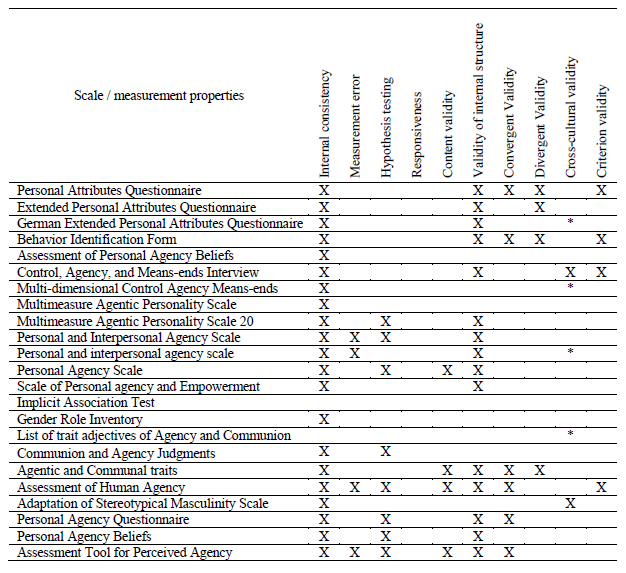
Note: * Process carried out partially or incompletely.
Through the synthesis proposed by Table 2, it should be noted that no instrument demonstrated the responsiveness of the instrument. It is also possible to verify that not all the tools presented different types of validity, and five instruments present conceptual and statistical designs that were not very deep. Such elements were not found in the documents that present their development or were not available.
Discussion
The identified instruments are analyzed from three prisms: a) theoretical perspectives and historicity of the instruments; b) psychometric properties and; c) population and sample of the studies which developed the instruments and languages that are available.
Theoretical perspectives and historicity of instruments
Different theoretical perspectives regarding studies on agency can be observed through the measurement instruments of the construct from the theoretical framework that supports them and are reflected in the dimensionality of the scales. The first instruments identified are aligned with the theoretical perspective that relates sex, gender and the influence on agency and communality, which is based on the idea of representation of social roles of men and women and the associated stereotypes. From this understanding, the sense of agency is associated with the masculine, with characteristics of determination, individualism, action, competence, ambition, dominance, and objectivity, for example. The sense of communality, on the other hand, is directed to the feminine, contemplating care, collectivism, morality, interdependence and parental investment, for example (Abele et al., 2008). We identified nine instruments in alignment with this perspective: PAQ, EPAQ, GEPAQ, IAT, GRI-14, AC, ACJ, AC and ASMS.
The other theoretical perspective observed in the instruments is associated with the triadic reciprocal causation model and metacognitive processes. This model assumes that environmental factors, personal factors, and motivation for action and behavior influence one other in agency capacity. Metacognition plays a fundamental role in this process, in which the main resources are intentionality, premeditation, self-reactivity and self-reflection (Bandura, 2001, 2018). Fourteen instruments are associated with this perspective: BIF, APAB, CAMI, Multi-CAM, MAPS, MAPS-20, PIAS, EAPI, PAS, ESAGE, AHA, AQ, PAB and ATPA-22.
Even with 14 instruments developed, which consider distinct dimensionalities related to the triadic reciprocal causation model and metacognitive processes, no instrument was identified that addresses all the agency factors identified by Gai et al. (in press). The authors propose an expanded dimensionality of personal agency from the bandurian perspective, which include: intentionality, premeditation, self-reactivity, self-reflection, self-efficacy and internal control. This model contemplates the metacognitive processes indicated by Bandura (2001), as well as self-efficacy (Bandura, 1989) and internal control proposed by Rotter (1966). This indication of a possible limitation regarding the theoretical basis in the construction of these instruments, which is reflected in the dimensionality of the scales.
Regarding the temporal distribution of the development of these scales, different movements were observed regarding the development of instruments from different theoretical perspectives (Figure 2).
Based on Figure 2, we can observe that the instruments that refer to agency and commonality and gender stereotypes are older and recommend tooling for measuring the construct. However, they have less consistency regarding the development of new scales, since as after the 1981 scale new instruments were only identified in 2006, and we found no tools have been made since 2015. Conversely, even with the first instrument related to this perspective dating back to 1989, the theoretical line that associates agency and the triadic reciprocal causation model and the metacognitive processes presents greater consistency in the development of new instruments.
The reason for the decrease in the use of instruments associated with the notion of agency and gender stereotypes may be associated with the demystification of this stereotype, especially since they are related to impairments in emotional development and maturation, leading to psychological distress (Jesus et al., 2020). The influence of interpersonal relationships on the perception of agency is amplified by Landes and Settersten Jr. (2019), who criticize the lack of recognition of this aspect in the literature, even though it is encompassed in the conceptualization of Bandura as part of external influencers. The authors understand that human agency is dependent on relational aspects and propose that the conceptualization and measurement of agency require the consideration that people's lives are interconnected, and that the perception of total “independence” is flawed, contradicting the notion of antagonism between agency and communality.
Psychometric properties of instruments
Based on the analysis of the psychometric properties of the selected instruments, the use of Classical Test Theory was identified in the analysis of all tools that provided this data, and we found no use of Item Response Theory. Among these observed properties, the predominant use of Cronbach's alpha in the instruments confirms the preference to analyze internal consistency or reliability (Zanon & Hauck Filho, 2015). The instruments identified presented alpha values between .61 and .95. That is, most have acceptable values (Hair Jr. et al., 2019).
Regarding validity criteria, most instruments provided evidence of validity of internal structure, especially with the use of exploratory and confirmatory factor analysis. The other types of validity observed most often, although in smaller numbers, are convergent validity -in six instruments- and divergent validity -in four instruments-. When considering the lower number of tools that performed this process, it is possible to corroborate the statement of Henderson (2002) about the difficulty in identifying instruments of well-validated measures to perform the verification of these two types of validation. This difficulty may also be related to the lack of conceptual clarity about agency in order to establish the constructs that present analogous or antagonistic characteristics.
Cross-cultural validity was verified in only one instrument -the adaptation of Stereotypical Masculinity Scale, by Bem (1974)- performed by Besta et al. (2015). However, this information does not represent an indication that this stage was not contemplated in the articles due to methodological failure, since most of them are about the development of the instruments and not about cross-cultural adaptations. In the cases of the instruments of Runge et al. (1981) and De Fontes et al. (2010), cross-cultural validation was not complete, since only the first stages of this process were provided, limited to semantic validation with translation and back-translation of the instruments. The steps for a complete cross-cultural adaptation refer to translation, synthesis of translations, back-translation, synthesis of back-translations, expert committee and pre-test (Beaton et al., 2000). Although the cross-cultural validation process was not mentioned, three instruments were constructed in different languages: AC, CAMI and Multi-CAM. However, they do not present the psychometric properties of these different versions.
Regarding psychometric properties, when analyzing the methodological aspects of this group of instruments, we observed that not all of them provided different types of validity evidence, which indicates poor robustness of the proposed analyzes, especially considering that many have little in-depth statistical analyzes. It is noteworthy the absence of clear language about the measurement properties used for analysis of the instruments, which are not written objectively in all cases, and can hinder the understanding of the quality of the instruments for readers who are not so familiar with the statistical terms and tests.
Population, sample and language of the instruments
The instruments identified are aimed at different population groups, as observed in the distribution of the study sample, which included: children and adolescents, youth and students, adults (unspecified) and professionals. As for the tests indicated for children and adolescents, we found two: the CAMI and the Multi-CAM. Samples of students and young people were found in nine studies that set out to develop the instruments. Targeting this group may be associated with the importance of agency for decisions related to career and insertion in the work force. This is also justified in the cases of samples with adults, identified in ten studies, and with professionals, observed in two studies. These data reinforce the importance of measuring agency, especially due to the implications of the phenomenon in perceptions about career (Chen & Hong, 2020) and proactive responses to situations involving the educational and professional environment (Betz, 1987).
As for the language, 19 of the 23 instruments identified are available in English and only 7 exist in other languages. The second language with the largest number of scales is German, with three instruments (GEPAQ, CAMI and Multi-CAM), followed by Polish, with two instruments (SMS and AC). In Russian there are also two instruments (CAMI and Multi-CAM). The languages that presented only one instrument for agency measurement are Portuguese (EAPI), Spanish (ESAGE), Japanese (CAMI), French (AC) and Italian (AC). The existence of the same instrument in different languages makes it possible to use this measure in a larger territorial extension, enabling comparative studies between different countries and cultures.
Conclusion
From the execution of this systematic literature review in which we sought to analyze the psychometric properties of instruments for measuring personal agency, we identified 23 instruments that propose to measure personal agency in a specific way. Of the 55 documents analyzed, some are specifically aimed at the construction or adaptation and validation of these instruments, while others presented empirical research using these tools.
Two groups of instruments were observed based on the theoretical support that underpins them, identified in the aforementioned literature and the factors that make up the scales. The first instruments are based on the perception of agency and commonality, derived from gender stereotypes. The second strand of instruments is aligned with the triadic reciprocal causation model and metacognitive processes, which contemplate the greatest number of tools. We identified no instruments that concomitantly contemplate the expanded dimensionality of agency proposed by Gai et al. (in press): intentionality, premeditation, self-reactivity, self-reflection, self-efficacy and internal control, something that emphasizes the need to build new instruments.
There are weaknesses regarding the robustness of the psychometric properties of the instruments, since most are limited to the provision of validity evidence of internal structure. Convergent and divergent validities are little explored, which may be due to the difficulty in identifying instruments that enable this verification, or due to the lack of conceptual clarity about agency in order to establish these criteria. We identified no instruments for measuring agency with statistical validity for Portuguese, nor in the Brazilian context. The only instrument adapted for this language presented only semantic validation -the Agency Beliefs (Smith et al., 2000) adapted by Fontes et al. (2010).
From this data, we consider that the development of an instrument adapted to the Brazilian context is the main recommendation of studies from this systematic review. The lack of an instrument that meets the validity criteria hinders the advances in the literature on agency in the country. The construction of an instrument that contemplates the expanded dimensionality of agency proposed by Gai et al. (in press) would make it possible to fill this theoretical gap. Such an instrument can be an option for researchers who have been studying the subject and end up using instruments to measure related constructs, as in the case of the study by Dressler et al. (2019).
Among the limitations of this study, even with six databases being screened, it is still possible that other instruments were left out, due to the difficulty of covering all available studies and also because documents of gray literature were not considered. Additionally, we studied documents from up until the year 2020, and some of the documents that developed instruments could not be accessed, which limited the description of the development of the tool and its psychometric properties. As suggestions for future studies, it is worth recommending research development in languages other than English, since, out of the 23 instruments studied, only six were not in this language. This may be one of the possible justifications for the small number of studies about agency capacity in Latin America, including Brazil.
REFERENCES
Abele, A. E., Uchronski, M., Suitner, C., & Wojciszke, B. (2008). Towards an operationalization of the fundamental dimensions of agency and communion: Trait content ratings in five countries considering valence and frequency of word occurrence. European Journal of Social Psychology, 38(7), 1202-1217. https://doi.org/10.1002/ejsp.575 [ Links ]
Alkire, S. (2005). Subjective quantitative studies of human agency. Social Indicators Research, 74(1), 217-260. https://doi.org/10.1007/s11205-005-6525-0 [ Links ]
Bandura, A. (1989). Human agency in social cognitive theory. American Psychologist, 44(9), 1175. https://doi.org/10.1037/0003-066X.44.9.1175 [ Links ]
Bandura, A. (2001). Social cognitive theory: An agentic perspective. Annual review of psychology, 52(1), 1-26. https://doi.org/10.1146/annurev.psych.52.1.1 [ Links ]
Bandura, A. (2018). Toward a psychology of human agency: Pathways and reflections. Perspectives on Psychological Science, 13(2), 130-136. https://doi.org/10.1177/1745691617699280 [ Links ]
Beaton, D. E., Bombardier, C., Guillemin, F., & Ferraz, M. B. (2000). Guidelines for the process of cross-cultural adaptation of self-report measures. Spine, 25(24), 3186-3191. https://doi.org/10.1097/00007632-200012150-00014 [ Links ]
Bem, S. L. (1974). The measurement of psychological androgyny. Journal of Consulting and Clinical Psychology, 42(2), 155-162. https://doi.org/10.1037/h0036215 [ Links ]
Besta, T., Mattingly, B., & Błażek, M. (2015). When membership gives strength to act: Inclusion of the group into the self and feeling of personal agency. The Journal of Social Psychology, 156(1), 56-73. https://doi.org/10.1080/00224545.2015.1053838 [ Links ]
Betz, N. E. (1987). Use of discriminant analysis in counseling psychology research. Journal of Counseling Psychology, 34(4), 393-403. https://doi.org/10.1037/0022-0167.34.4.393 [ Links ]
Cauce, A. M. & Gordon, E. W. (2012). Toward the measurement of human agency and the disposition to express it. Gordon commission on the future of educational assessment, Princeton, Educational Testing Service. https://www.ets.org/Media/Research/pdf/cauce_gordon_measurement_human_agency.pdf [ Links ]
Chen, C. P. & Hong, J. W. L. (2020). The Career Human Agency Theory. Journal of Counseling & Development, 99(2), 193-199. https://doi.org/10.1002/jcad.12313 [ Links ]
Dressler, W. W., Balieiro, M. C., & dos Santos, J. E. (2019). Agência, consonância cultural e sintomas depressivos: um exemplo brasileiro. Ethos, 47(2), 148-167. https://doi.org/10.1111/etho.12238 [ Links ]
Fontes, A. P., Neri, A. L., & Yassuda, M. S. (2010). Enfrentamento de estresse no trabalho: relações entre idade, experiência, autoeficácia e agência. Psicologia: Ciência e Profissão, 30(3), 620-633. https://doi.org/10.1590/S1414-98932010000300013 [ Links ]
Friestad, C. & Skog Hansen, I. L. (2010). Gender differences in inmates’ anticipated desistance. European Journal of Criminology, 7(4), 285-298. https://doi.org/10.1177/1477370810363375 [ Links ]
Gai, M. J. P., Viseu, J. N. R., Cruz, R. M., & Kaczam, F. (no prelo). Perspectivas teóricas dos estudos sobre agency: uma revisão integrativa. Estudos de Psicologia. [ Links ]
Graff, M. (2016). Cognitive and affective aspects of personality and academic procrastination: The role of personal agency, flow, & executive function. (Tese de doutorado, City University of New York). https://academicworks.cuny.edu/cgi/viewcontent.cgi?article=2489&context=gc_etds [ Links ]
Hair Jr., J. F., Black, W. C., Babin, B. J., & Anderson, R. E. (2019). Multivariate Data Analysis (8a ed.). Cengage. [ Links ]
Henderson, S. J. (2002). The correlates of inventor motivation, creativity and achievement. (Tese de doutorado, Stanford University). Stanford University ProQuest. https://www.proquest.com/docview/305543449?pq-origsite=gscholar&fromopenview=true [ Links ]
International Test Commission. (2014). ITC guidelines on quality control in scoring, test analysis, and reporting of test scores. International Journal of Testing, 14(3), 195-217. https://doi.org/10.1080/15305058.2014.918040 [ Links ]
Jesus, C. A., Preto, L. A., Ferreira, B. F., & Vicente, M. F. K. (2020). Estereótipos de gênero e seus impactos na psique humana. Revista Científica Sophia, 1(1), 70-87. [ Links ]
Kabeer, N. (1999). Resources, agency, achievements: Reflections on the measurement of women’s empowerment. Development and Change, 30(3), 435-464. https://doi.org/10.1111/1467-7660.00125 [ Links ]
Landes, S. D. & Settersten Jr, R. A. (2019). The inseparability of human agency and linked lives. Advances in Life Course Research, 42, 100306. https://doi.org/10.1016/j.alcr.2019.100306 [ Links ]
Lautamo, T., Paltamaa, J., Moilanen, J., & Malinen, K. (2020). Psychometric properties of the Assessment Tool for Perceived Agency (ATPA-22): utility for the rehabilitation of young adults not in education, employment or training (NEETs). Scandinavian Journal of Occupational Therapy, 28(2) 97-109. https://doi.org/10.1080/11038128.2020.1782983 [ Links ]
Mokkink, L. B., Prinsen, C. A. C., Bouter, L. M., Vet, H. C. W. de, & Terwee, C. B. (2016). The COnsensus-based Standards for the selection of health Measurement INstruments (COSMIN) and how to select an outcome measurement instrument. Brazilian Journal of Physical Therapy, 20(2), 105-113. https://doi.org/10.1590/bjpt-rbf.2014.0143 [ Links ]
Mokkink, L. B., Terwee, C. B., Patrick, D. L., Alonso, J., Stratford, P. W., Knol, D. L., Bouter, L. M., & de Vet, H. C. W. (2010). The COSMIN checklist for assessing the methodological quality of studies on measurement properties of health status measurement instruments: an international Delphi study. Quality of Life Research, 19(4), 539-549. https://doi.org/10.1007/s11136-010-9606-8 [ Links ]
Munn, Z., Peters, M. D., Stern, C., Tufanaru, C., McArthur, A., & Aromataris, E. (2018). Systematic review or scoping review? Guidance for authors when choosing between a systematic or scoping review approach. BMC medical research methodology, 18(1), 1-7. https://doi.org/10.1186/s12874-018-0611-x [ Links ]
Pacico, J. C. & Hutz, C. S. (2015). Validade. Em C. Hutz, C., Bandeira, D.R., & Trentini, C.M. (Orgs.), Psicometria (pp. 71-84). Artmed. [ Links ]
Page, M. J., McKenzie, J. E., Bossuyt, P. M., Boutron, I., Hoffmann, T. C., Mulrow, C. D., Shamseer, L., Tetzlaff, J. M., Akl, E. A., Brennan, S. E., Chou, R., Glanville, J., Grimshaw, J. M., Hróbjartsson, A., Lalu, M. M., Li, T., Loder, E. W., Mayo-Wilson, E., McDonald, S., … Moher, D. (2021). The PRISMA 2020 statement: an updated guideline for reporting systematic reviews. BMJ, 372(n71). https://doi.org/10.1136/bmj.n71 [ Links ]
Pasquali, L. (2003). Teoria da medida. Em L. Pasquali (2017). Psicometria: teoria dos testes na psicologia e na educação (pp. 23-51). Vozes. [ Links ]
Pasquali, L. (2007). Validade dos testes psicológicos: será possível reencontrar o caminho? Psicologia: teoria e pesquisa, 23(spe), 99-107. https://doi.org/10.1186/s12874-018-0611-x [ Links ]
Pick, S., Sirkin, J., Ortega, I., Osorio, P., Martínez, R., Xocolotzin, U., & Givaudan, M. (2007). Escala para medir Agencia Personal y Empoderamiento (ESAGE). Interamerican Journal of Psychology, 41(3), 295-304. [ Links ]
Polit, D. F. (2015). Assessing measurement in health: Beyond reliability and validity. International Journal of Nursing Studies, 52(11), 1746-1753. https://doi.org/10.1016/j.ijnurstu.2015.07.002 [ Links ]
Primi, R. (2012). Psicometria: fundamentos matemáticos da Teoria Clássica dos Testes. Avaliação Psicológica, 11(2), 297-307. [ Links ]
Rotter, J. B. (1966). Generalized expectancies for internal versus external control of reinforcement. Psychological Monographs: General and Applied, 80(1), 1-28. https://doi.org/10.1037/h0092976 [ Links ]
Runge, T. E., Frey, D., Gollwitzer, P. M., Helmreich, R. L., & Spence, J. T. (1981). Masculine (instrumental) and feminine (expressive) traits: A comparison between students in the United States and West Germany. Journal of Cross-Cultural Psychology, 12, 142-162. https://doi.org/10.1177/0022022181122002 [ Links ]
Smith, G. C., Kohn, S. J., Savage-Stevens, S. E., Finch, J. J., Ingate, R., & Lim, Y.-O. (2000). The effects of interpersonal and personal agency on perceived control and psychological well-being in adulthood. The Gerontologist, 40(4), 458-468. https://doi.org/10.1093/geront/40.4.458 [ Links ]
Souza, A. C. D., Alexandre, N. M. C., & Guirardello, E. D. B. (2017). Propriedades psicométricas na avaliação de instrumentos: avaliação da confiabilidade e da validade. Epidemiologia e Serviços de Saúde, 26(3), 649-659. https://doi.org/10.5123/S1679-49742017000300022 [ Links ]
Vianna, H. M. (1983). Validade de construto em testes educacionais. Educação e Seleção, (8), 35-44. [ Links ]
Vidrine, J. I., Businelle, M. S., Cinciripini, P., Li, Y., Marcus, M. T., Waters, A. J., Reitzel, L. R., & Wetter, D. W. (2009). Associations of mindfulness with nicotine dependence, withdrawal, and agency. Substance Abuse, 30(4), 318-327. https://doi.org/10.1080/08897070903252973 [ Links ]
Zanon, C. & Hauck Filho, N. H. (2015). Fidedignidade. Em C. Hutz, C., Bandeira, D.R., & Trentini, C.M. (Orgs.), Psicometria (pp. 85-96). Artmed. [ Links ]
How to cite: Gai, M. J. P., Cruz, R. M., Viseu, J. N. R., Sales, S. S., & Nunes, C. (2023). Psychometric properties of agency measuring instruments: a systematic review. Ciencias Psicológicas, 17(2), e-2706. https://doi.org/10.22235/cp.v17i2.2706
Authors’ participation: a) Conception and design of the work; b) Data acquisition; c) Analysis and interpretation of data; d) Writing of the manuscript; e) Critical review of the manuscript. M. J. P. G. has contributed in a, b, c, d, e; R. M. C. in a, b, c, d, e; J. N. R. V. in c, d, e; S. S. S. in b, c, d; C. N. in b, c, d.
Received: October 13, 2021; Accepted: June 21, 2023











 text in
text in 


